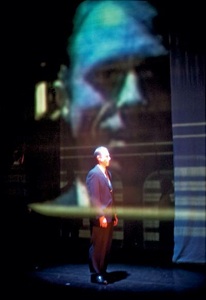Me beginning my keynote. Photo: Ciara Murphy.
I was extremely honoured to be invited to key a keymote address at the EDEN All-Island Postgraduate Conference at NUI Galway this week. The theme of the conference was Bodies and Borders and I saw a dazzling series of remarkable papers by postgraduate researchers, followed by excellent questions. A very high, indeed daunting standard.
My paper was ‘My Place or Yours? Reflections on Theatre, Borders and Brexit’ and I began by discussing Brexit and, specifically, the problem of the Irish border. This led to some reflections on the nature of border-drawing and the related (but not entailed) notion of national sovereignty. I I made a case for the inaptness of exclusionary national boundaries (of the kind people like Nigel Farage seem so romantically attached to). I noted that the Good Friday Agreement, which is imperilled by the British government's insistence on leaving the EU customs union and single market, is an imperfect document, which tends to foreclose on the plurality of identities in the North of Ireland and reify some rather conservative binaries. And yet, in its enshrinement of 'parity of esteem' there is the beginning of a deconstructive, relatviising attitude to identity that begins, just begins, to separate identity from nation, body and land. There are, of course, radical democrats who believe that the GFA should be dispensing with the very notion of cultural identity and on a certain theoretical level, I believe that myself. Of course, political theory and political practice can be rather different things and it's easy to think that the complex, ambiguous layering of provisional identities of the kind envisaged by radical democrats is an object of theoretical reflection but not, perhaps, an object of experience. Put more straightforwardly, we can imagine identity like that, but can we feel it?
And this is where the theatre comes in. Because typically in the theatre we experience identity and place as endlessly overlaid on one another. At the simplest level, when an actor plays a character there is an overlay of one identity over another; but even there, the actor's body is a visual echo of the other parts she or he has played, a kind of palimpsest, overwritten many times. And the character, too, is not a simple identity but, in the theatre, potentially reembodied and reinvented and reinterpreted limitless times. All identities in the theatre are ghosted and haunted and doubled and troubled. (And indeed the same is true of land; I rehearsed again Joanne Tompkins's argument about theatre as heterotopia, where the layered places - real world, theatre building, stage set and fictional world - interact in ways that open up and trouble the attachments and meanings of place in our lives, public and personal.
And to finish off, I then looked at a couple of recent plays which are set - unusually for British theatre - not in urban centres but in the country: Joe White's Mayfly (set in a village or small town in Shropshire) and Simon Longman's Gundog set on a farm, somewhere in England (and is, I think, one of the most exciting new plays I've seen in some years). I argued that both plays share a haunted sense of place, that their very spatial specificity creates a deconstructive energy that undermines the security of place. I also suggested that both plays share a structure of feeling that is mournful, melancholic, fearful, bleak but I am unsure whether that is a requiem for the nation or for the transcendence of nation.
There were some great questins afterward, the particular session chaired brilliantly by Patrick Lonergan. Galway is a beautiful city. I was taken from my hotel by the brilliant doctoral student Ciara Murphy along a gorgeous river and canal to the elegant university campus on a bright and beautiful day. It was a pleasure to attend and contribute to this superb conference.




![photo[1].jpg](https://images.squarespace-cdn.com/content/v1/513c543ce4b0abff73bc0a82/1362919072201-PZO854G4SEB794DVOEI8/photo%5B1%5D.jpg)
